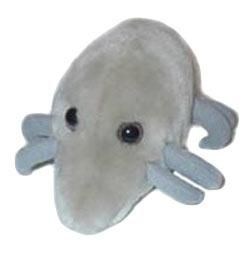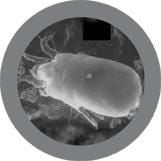Dust Mite (Dermatophagoides pteronyssinus)
£8.95
Unless you live in Antarctica, you've got millions of dust mites living in your house (and we didn't even count the ones in those corners you keep meaning to clean). See what you're up against -- or put these little reminders where they're needed most!
Product Details
Additional Information
| Sizes | Giantmicrobes are based on actual microbes, cells, organisms and other critters, only 1,000,000 times actual size! Gigantic (GG) 40-60cm XL (XL) 25-38cm Original (PD) 12-20cm Minis (MM) 5-10cm each Keychain (KC) 5-10cm with clip |
|---|---|
| Materials | Plush from all new materials. Stuffed with polyester fiber fill. Surface washable: sponge with water & soap, air dry. |
| Packaging | Each plush microbe includes a printed card with fun, educational and fascinating facts about the actual microbe or cell. |
| Safety | Every product meets or exceeds U.S. and European standards for safety. For ages 3 and up. |
All about Dust Mite (Dermatophagoides pteronyssinus)
| Description | Dust mites are tiny, microscopic insects that live in textiles and furniture, like carpets and beds. They’re commonly found everywhere in our environment and are impossible to eliminate. They love warm and humid places, and feed on dead skin flakes that people shed daily. At a rate of 1.6 pounds of skin shed per person every year, these tiny critters are kept well fed all year long! |
|---|
| Name | It’s name is derived from Latin roots. The genus name describes the bug’s eating habits. “Dermato” means skin “phago” means to eat. The species name describes the appearance of the bug. “Ptero” describes its feathery texture, and “sinus” describes its bent body shape. Ladies and gents, I present you with a skin-eating bug with feathers and a curved body. It’s the stuff sci-fi originated from! |
|---|
| Actual Size | 0.2 to 0.3 millimeters, or 4,000 times smaller than a golf ball! |
|---|
| Symptoms | These bugs aren’t parasites, they don’t bite, sting, or burrow into human bodies. Instead, their feces and body fragments are the harmful allergens that can trigger allergies and asthma symptoms like sneezing, runny nose, red and itchy eyes, coughing, and difficulty breathing. |
|---|
| History | First discovered in house dust in 1964 by Voorhorst, et. al, and Oshima. |
|---|
| Fascinating Facts | Dust mites have 8 legs and are closely related to spiders! |
|---|






